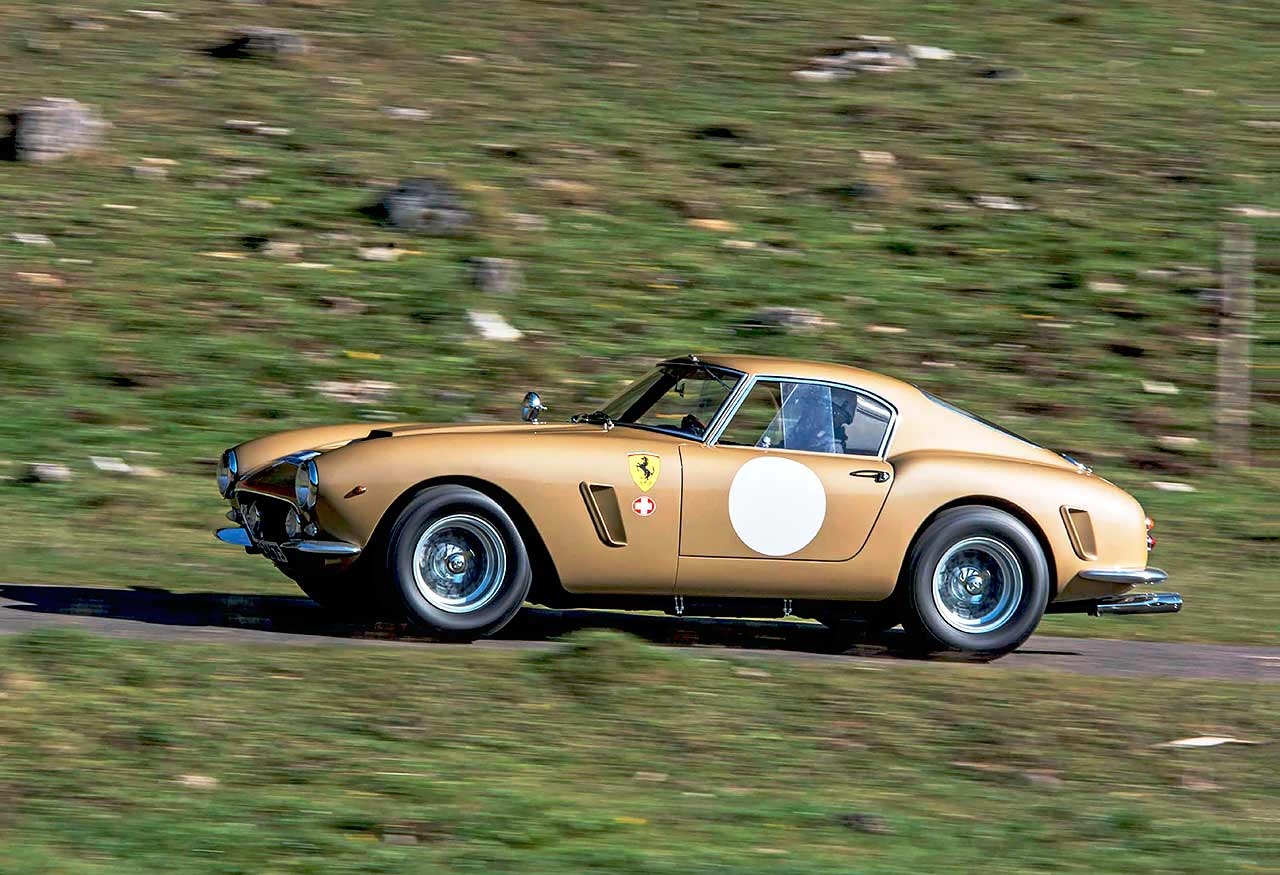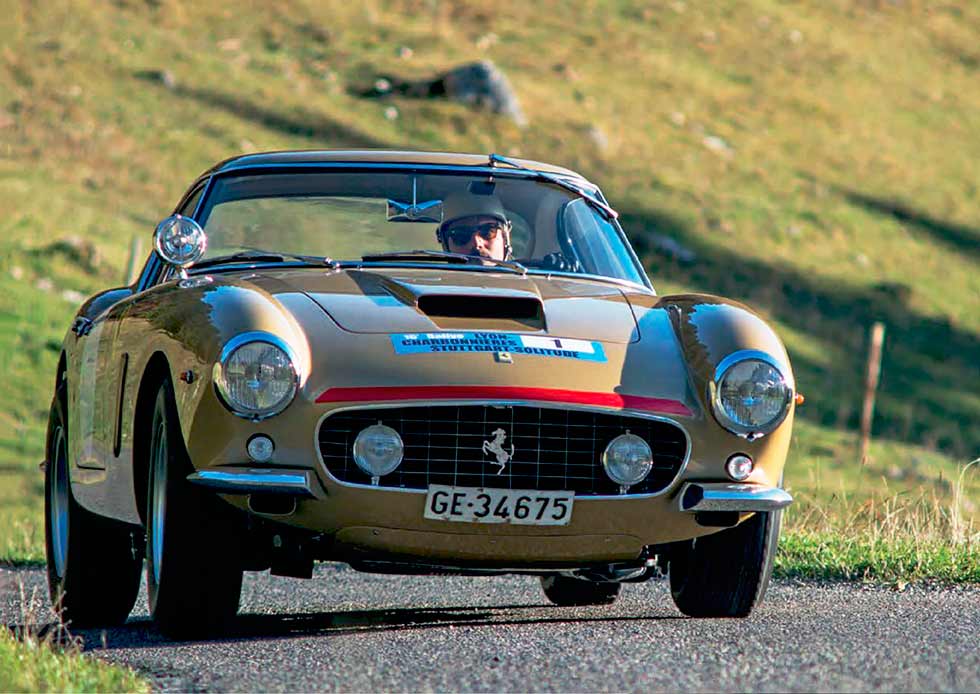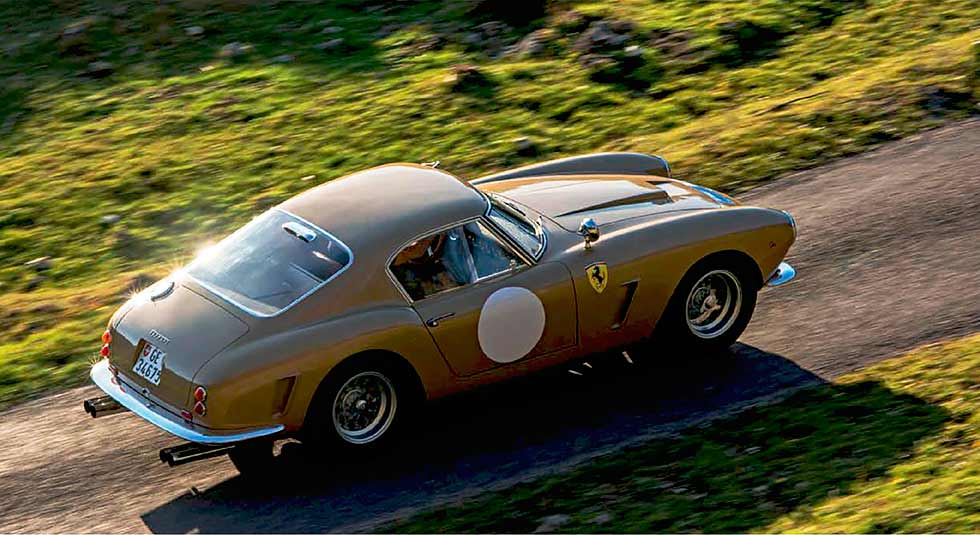
Special stage Berlinetta. Italian GT3 champion Mirko Venturi samples an historic 250SWB rally car. The world’s most unlikely rally car. Mick Walsh tells the amazing story of how this sublime 250GT Berlinetta became a star of the special stage in the early 1960s. Photography Mick Walsh.
Few modern hotshoes would go to the lengths that Italian Super GT3 champion Mirko Venturi has done for his first drive of a 1960s Ferrari. He started growing a moustache weeks before the test, to look like the little-known first owner of the 250SWB Berlinetta, Gérard Spinedi, a Swiss gentleman racer with Latin ancestry who ordered his new Ferrari to be painted a striking shade of gold. Venturi sought out period items, including vintage Ray-Bans borrowed from his grandmother.

He then spent evenings poring over books, magazines and old photographs of the Tour de France, Le Mans and Montlhéry to get a proper appreciation of a GT racing era that happened two decades before he was born. Venturi’s motorsport experience has certain parallels with the wealthy privateer because both competed mainly in Ferrari GTs, but the similarities end there. The cars – 250 LWB Tour de France and SWB, compared to 458 and 488 GT3 – are decades apart in layout, power and grip.
Like most of his contemporaries, Spinedi always motored to and from events with his wife, carrying a few essential tools and spares in the boot. Venturi’s mounts, in comparison, arrive in huge transporters with a team of mechanics. While Spinedi kept his cars at home and used them when he fancied – even today neighbours recall his beautiful gold Ferraris – Venturi’s racers merely exist, stripped down between events, in specialist workshops and never venture onto the street. Only by reputation is he known in Reggio Emilia, his home town, as a racing driver.
“This is the oldest car I’ve driven,” explains Venturi. “My only previous experience of a classic Ferrari was an F40 that was my bedroom pin-up when I was a boy. I was a little apprehensive about the 250SWB because it has such a fabled status in Maranello history, and I didn’t want to be disappointed. But I started to get very excited days before the photo-shoot.”

To give Venturi’s drive authenticity, the newly restored 1960 250SWB, chassis 2159GT, is taken up into the foothills of the Jura Vaudois, just north of Geneva. This stunning gold GT could well have been tested in period on these sub-Alpine roads through the tranquil woods. Spinedi would have driven here from his nearby home to practise for the Tour de France or the Rallye Lyon-Charbonnières-Stuttgart-Solitude.
As Venturi takes the wheel for the first time, gradually gaining confidence and stretching the revs, the yowling V12 echoes around the hills. As the GT flashes between shade and sun – climbing the narrow, twisty road – it sounds like two chasing SWBs. Venturi makes several runs up and down the valley, returning each time with a bigger smile. He switches off the engine, taking time to soak up the privileged experience, and relates his feelings about the revered machine.
“I love the engine and gearbox,” he enthuses. “You can really feel the power right through the rev range, and its fantastic throttle response is so progressive. It’s easy to appreciate that this car could be driven every day. The gearbox has a superb change and the ratios perfectly match the engine. There’s a lot of transmission noise inside the cabin, though, and I’m sure the V12 must sound much better from outside. The brakes, once warm, are better than expected with good feel, but the biggest shock is the steering, which I wasn’t sure about at first. There’s a lot of play compared to a modern GT, and it quickly confirms that I have to respect its limits.”
With little encouragement, Venturi sets off for another blast up the deserted pass. As the light fades, the metallic paint reflects the last rays of sun and, with the headlamps now on, the Ferrari is definitely going faster. Through the more open turns, Venturi sets up a classic power drift, the modern ace clearly relishing the SWB’s limited grip compared to his 488. It’s almost dark when he finally stops, and the flashing grin illustrates how much fun he’s been having.
“It’s fantastic and perfect for these mountain roads,” he says, beaming. “I’m used to precise controls, wide tyres and a super-fast gearbox, but this has a more natural feel and it lets you play through the corners. The handling is predictable and balanced, but you have to work the car. It’s very physical. There’s a little fight as you saw at the steering through the apex, but it’s so rewarding.
The cockpit is snug, the bucket seats offer good support and the driving position suits me, but it would feel tight for a taller driver. This car has great character, but the engine is the best part for me. I love the smooth power and at high revs it feels and sounds aggressive. With every mile as I start to understand it more, my love just gets stronger. It will be a tough separation.”
Clearly smitten, Venturi is full of awe for the likes of Spinedi: “Real heroes, driving in cotton shirts, sunglasses and an open-face, Fantino-style helmet – just like polo players. As soon as the engine starts, you go straight back to those days. You can’t help thinking about the history, and I feel a very lucky man to test this amazing car.”
In the twilight, the Pininfarina beauty looks even more exquisite, and it’s hard to imagine that the body was originally hand-beaten by Scaglietti’s artisans. We don’t see a modern car for hours and, with Venturi sporting his authentic gear, we could be back in the early ’60s.
With a fortune made by the construction firm started by his father in Italy, Spinedi indulged in GT racing, initially with Alfas, then Ferraris. His first V12 exotic was a Tour de France that he bought from Luigi Taramazzo, who took part in local hillclimbs. Spinedi immediately had it painted gold with four full-length white stripes.
Story has it that he chose the bold shade to match the locks of his glamorous Persian-born wife Aghdass, who became a familiar figure on events as navigator and occasional co-driver. She also competed with her own Mini Cooper.
After several Swiss events, including the Geneva Rally, Spinedi became more serious and stepped up to international level with entries on the 1960 Tour de France and the Coupe des Alpes with the TdF. He was clearly frustrated by the old long-wheelbase GT, though, and quickly placed an order with Maranello for a new lightweight 250GT Berlinetta Competizione via his local dealer Garage Monchoisy. Spinedi specified a hot engine, the Tipo 168B unit featuring Testa Rossa-type heads, plus larger intake and exhaust valves and triple Weber 40DCL 6 carburettors.
The factory dyno sheets confirmed 269bhp, a healthy 40bhp up on the usual spec. Other special details for this first-series competition model included a spotlight on the passenger-side wing, while an extra wiper for the driver was fitted above the windscreen. For his wife’s comfort, the passenger seat reclined and had a removable headrest. As with many bespoke SWB Competiziones, the body retained bumpers but they were shaped from aluminium.
Finished in Spinedi’s signature gold livery with a red strip across the nose (the style of the flash was often changed during three very active years), the 250SWB was immediately entered on the arduous Rallye Lyon-Charbonnières-Stuttgart- Solitude in March 1961. Spinedi chose Jo Schlesser as his co-driver – the Gallic racer who was just finding form looked ideal for this French championship event, which featured special sections – often on snow – on high-altitude passes, and circuit races. The Ferrari’s chances were hampered by ignition problems and, although they failed to register in the results, Schlesser made up for the poor reliability with a dramatic victory at the Solitude road circuit.
After that disappointing debut, Spinedi had a superb season with his new car, winning the Cern 1000km, plus two climbs at Côte de Verbois and Chermignon-Crans as well as an impressive second on the Coupe de Vitesse at Montlhéry. For their first Tour de France in the SWB, Spinedi’s wife accepted the pressure as navigator for the demanding eight-day, 5000km September enduro, but they retired after a minor accident. The Ferrari was quickly repaired and then lined up with 11 other SWBs for the Paris 1000km at Montlhéry. Here, with French rally champion Roger de Lageneste as co-driver, they took on a class field. There was an epic 250SWB battle between the victorious Rodríguez brothers, plus the Écurie Francorchamps duo of Willy Mairesse and Lucien Bianchi. After 6½ hours of racing, Spinedi and de Lageneste finished 13th – just behind the Volpi équipe 250SWB, gunned by GP stars Graham Hill and Jo Bonnier.
Spinedi’s Ferrari was a fixture of circuit and hillclimb fixtures throughout the following European seasons because he clearly loved driving 2159GT. Despite the arrival of the GTO, the older Ferrari remained competitive as Spinedi upgraded his trusty SWB with the latest tweaks while lightening the body by a further 36kg.
Highlights in 1962 included victories on the Mont-Blanc Rally, plus numerous climbs and a second on the Coupe de Vitesse, but a fraught Tour de France ended after another retirement. That luck was to change on Équipe Spinedi’s third attempt, with an impressive fourth place on the gruelling 1963 Tour de France – after nine circuits, seven hillclimbs and 5700km covered.
The only Ferraris ahead of them were two 250GTOs, while Aghdass was hugely impressive setting the fastest time up the Col de Braus – the event required co-pilots to drive one section. After just two events in ’1964 – culminating with a GT class win on the Lans-Crans hillclimb – Spinedi decided to retire from motorsport, and eventually sold the faithful 2159GT. The glamorous couple in the unmistakable Ferrari would be much missed from the European scene.
The still highly original competition SWB then passed through the hands of several Ferrari connoisseurs until acquired by Lord Cowdray, better known as Michael Pearson. Red by then, it returned to France for the Tour Auto in 1994 and ’1995. Subsequent owners included Australian Kerry Manolas and Portugese historic racer José Albuquerque, who competed twice in the RAC TT Celebration at Goodwood in 2010 and ’2011.
In 2013, this important 250SWB returned to Switzerland where an investigation confirmed its originality – the only modifications being components replaced during Spinedi’s tenure. In association with Kidston SA, the car’s fascinating history was researched prior to its first major renovation. During the project, the Genevabased specialist tracked down Aghdass Spinedi, who provided details and a wealth of photographs of her late husband’s old racer. Early on during the rebuild, the new owner was convinced that the car should at last be returned to its signature gold with two-tone fawn upholstery.
A stripdown by top specialists began once Ferrari Classiche had certified the car. While the body was rebuilt by Carrozzeria Cremonini of Lesignana – where the outer skin was carefully removed from the chassis/frame – the mechanicals went to Autofficina Bonini near Reggio Emilia. With the Spinedi family helping to guide the colour choice, the car slowly came back together: Gatti tackled the electrics and Tappezzeria Andrea & Stefania Maieli near Mantova was enlisted to retrim the interior.
Simon Kidston and Emanuele Collo regularly visited Maranello to advise and monitor progress, and soon agreed that the much-loved 250SWB should drive as well as it looked. Exacting details to replicate the Spinedi years included refitting a period spotlamp and the third windscreen wiper, while old-style rally decals were remade. Finishing touches comprised the distinctive red nose stripe and replacing the original Geneva registration plates before the car was transported to California for its post-restoration debut at the Pebble Beach Concours in August last year.
What Spinedi would have made of the famous concours will never be known, but he would have been proud that the SWB picked up a second in class to a Ferrari 330 P4 – one of the all-time greatest racing cars. I’m sure, though, that the original owner would have gained more pleasure from witnessing Venturi’s test drive in the Jura foothills. As this stunning metallic-gold GT howls up the road one last time, you can sense his spirit in the Ferrari’s colourful history.
Thanks to Mirko Venturi; Emanuele Collo and Simon Kidston at www.kidston.com
‘AFTER 6 ½ HOURS OF RACING, THEY FINISHED JUST BEHIND THE SWB OF HILL AND BONNIER’


{module Ferrari 250}





